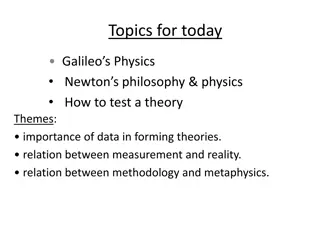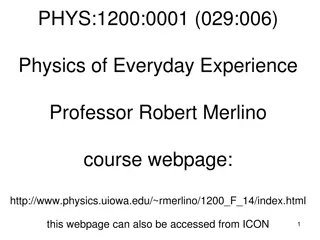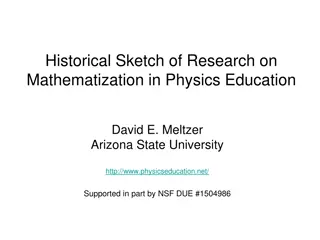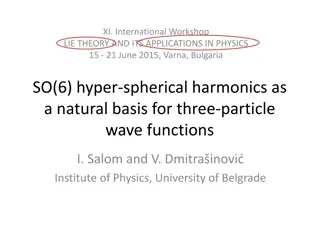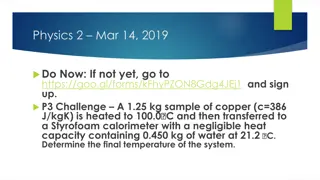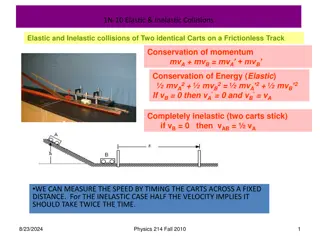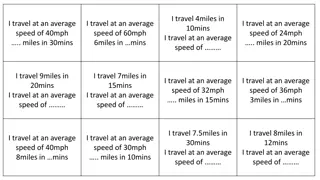Physics Concepts Illustrated with Images
Explore various physics concepts such as sound waves, light bending, resonance, wave velocity, and more through visually engaging images and related questions. Concepts like guitar string vibrations, compression waves, refraction of light, tuning fork vibration, and sound wave frequency are explained with clarity. Discover the principles behind phenomena like interference, resonance, wave velocity, and hearing loss risks in different occupations.
Download Presentation

Please find below an Image/Link to download the presentation.
The content on the website is provided AS IS for your information and personal use only. It may not be sold, licensed, or shared on other websites without obtaining consent from the author. Download presentation by click this link. If you encounter any issues during the download, it is possible that the publisher has removed the file from their server.
E N D
Presentation Transcript
1.[SP04-11 #55] The pitch of a sound made by plucking a guitar string is determined by the F frequency of the vibration produced G strength of the plucking force H distance between the strings J shape of the guitar body
2.[SP04-10 #37] Which illustration best demonstrates compression waves?
3.[JY04-11 #14] When trying to spear a fish in water, a person needs to take into account the way light bends as it moves from water into air. The bending of light as it passes from one medium into another is known as F reflection G refraction H diffraction J polarization
4.[SP03-11 #32] One tuning fork is struck and placed next to an identical fork. The two forks do not touch. The second tuning fork starts to vibrate because of A interference B the Doppler effect C resonance D standing waves
5.[JY04-11 #7] Which wave has the greatest velocity?
6.[SP03-11 #44] According to the table, which workers have the greatest chance of experiencing significant hearing loss over time? A Police traffic officers B Shoe-factory workers C Road-construction crews D Library desk clerks
7.[SP03-10 #38] At 0C sound travels through air at a speed of 330 m/s. If a sound wave is produced with a wavelength of 0.10 m, what is the wave s frequency? F 0.0033 Hz G 33 Hz H 330 Hz J 3300 Hz
8. A guitar player is seated next to a piano. The piano player strikes an E key on the piano. The guitarist reports that this causes the E string on his guitar to vibrate. What is the name of this phenomenon? A Polarization B Resonance C Reflection D Diffraction
9. A surface wave generated by an earthquake was recorded at Seismic Station 1. Forty seconds later the same wave was recorded at Seismic Station 2. What accounts for the time difference? F The origin of the wave is closer to Seismic Station 1. G The speed of the wave decreases with distance. H The wavelength is longer at Seismic Station 2. J The wave frequency increases when the wave passes through soil.
10. The diagram shows waves approaching a barrier. Which pattern will be formed after the waves pass through the opening in the barrier?
11. The speed of sound in human tissue is about 1600 m/s. If an ultrasound pulse takes 1.5 10-5 s to travel through a tissue, what is the thickness of the tissue? F 2.4 km G 2.4 m H 24 cm J 24 mm
12. A tuning fork with a frequency of 256 Hz vibrates when struck. Because of these vibrations, a nearby tuning fork begins to vibrate without being struck. Which of the following best accounts for the vibration of the second tuning fork? F Resonance G Polarization H Diffraction J Refraction
13. When a DVD is read, laser light touches the DVD surface and is then measured at location A. What allows light to return to location A after striking the DVD surface? F Conduction G Refraction H Magnification J Reflection
14. An empty cup was tightly covered with plastic wrap, and a few grains of salt were sprinkled on top of the plastic. When a tuning fork was struck and placed slightly above the plastic wrap, the salt began to move. Which characteristic of waves does the movement of the salt best demonstrate? A Echo formation B Diffraction C Resonance D Specular reflection
15. Diverging lenses are useful to people who suffer from nearsightedness because the lenses can cause images of distant objects to be focused on the retina. Lenses allow images to be focused on the retina because of F diffusion G reflection H diffraction J refraction
16. Which label on the model represents a wavelength? F G H J Q R S T
17. A surfer wishing to ride a big wave is most interested in a wave s A rarefaction B compression C amplitude D wavelength
18. A diver on a springboard can increase the height of a jump by repeatedly flexing the knees with a rhythm that matches the springboard s natural frequency. This is an example of A interference B reflection C resonance D polarization
19. Earthquake waves are detected by an instrument called a seismograph, and the data are recorded visually on a seismogram. To determine the location of an earthquake, scientists must determine the amount of time between the first arrival of the P wave and the first arrival of the S wave at the location of the seismograph. According to the data in the seismogram shown above, how much time elapsed between the arrival of the P wave and the arrival of the S wave? A 11 seconds B 25 seconds C 37 seconds D 90 seconds
20. Diagram 1 represents a wave. Diagram 2 represents the composite wave formed when a second wave interferes with the original wave. Which of the following best represents the second wave?
21. Which of the following indicates one wavelength of the wave shown above? A W to X B X to Y C W to Y D Y to Z
Answer key: 1. F 2. B 3. G 4. C 5. G 6. C 7. J 8. B 9. F 10. B 11. J 12. F 13. J 14. C 15. J 16. F 17. C 18. C 19. C 20. A 21. C











